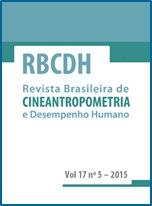Effects of downhill walking training on aerobic and neuromuscular fitness of young adults
DOI:
https://doi.org/10.1590/1980-0037.2015v17n5p539Resumen
Eccentric exercise training using low intensity-high volume approach has been performed to improve maximal muscle strength and power. The aim of this study was to compare the effects of short-term downhill walking and level walking training on lower limb strength and maximal oxygen uptake of active individuals. Eighteen young adults were divided into level walking group (n = 9) or downhill walking training group (n = 9). Both groups performed a four-week training program. The level walking group performed seven level walking sessions per week, while the downhill walking group walked downhill (-16%) in the same weekly frequency. One week before and one week after the training protocol, maximal oxygen uptake, muscle-bone cross-sectional area and isometric peak torque of knee extensors and plantar flexors were assessed for both groups. A significant group vs. time interaction was found only for cross sectional area of plantar flexors (PF), showing increases for the downhill walking group (112.6 ± 28.9 cm2 vs. 115.9 ± 29 cm2) but not for the level walking group (94.9 ± 23.3 cm2vs. 94.6 ± 228 cm2). Maximal oxygen uptake remained unaltered after training for both groups and IPT was increased after training for both groups. It was concluded that short-term downhill walking training does not seem to be efficient in promoting improvements in cardiorrespiratory fitness of young adults. However, it seems to promote gains in some variables related to neuromuscular fitness
Descargas
Publicado
Número
Sección
Licencia

Direitos Autorais para artigos publicados nesta revista são do autor, com direitos de primeira publicação para a revista. Em virtude da aparecerem nesta revista de acesso público, os artigos são de uso gratuito, com atribuições próprias, em aplicações educacionais e não-comerciais, desde que seja dada a atribuição. Esta obra foi licenciada com uma Licença Creative Commons Atribuição 4.0 Internacional - CC BY


